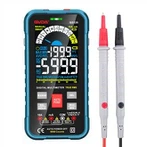Multimeter voltage measurement skills: multimeter voltage measurement steps and precautions
1. The method and steps of measuring voltage with a multimeter
First of all, the range switch should be aligned with the five gears marked with V (the AC voltage should be aligned with the AC voltage gear, and the DC voltage should be aligned with the DC voltage gear when testing the DC voltage).
Secondly, when measuring the voltage, the ammeter pen should be connected to the circuit under test. According to the approximate value of the circuit under test, select an appropriate range position. The maximum value of each dry battery is 1.5V, so it can be placed in the 5V range. At this time, the 500 of the full scale reading of the hands on the panel should be read as 5. i.e. scaled down by a factor of 100. If the pointer is at the 300 scale, it will be read as 3V. Note that the index value of the tip of the range switch is the corresponding value of the full scale reading of the pointer on the meter head. When reading the meter, you only need to convert it accordingly to read the real value. Except for the resistance range, all range switch ranges can read the measurement results in this way.
Finally, in the actual measurement, when the approximate value of the measured voltage cannot be determined, the switch can be turned to the maximum range first, and then the range can be reduced step by step to a suitable position. Pay attention to the positive and negative polarity when measuring DC voltage. If the test leads are reversed, the test needles will reverse. If you don't know the positive and negative polarity of the circuit, you can set the range of Wantian meter to the maximum range, test it quickly on the circuit under test, and see how the pen needle deflects, you can judge the positive and negative polarity.
2. Matters needing attention when measuring voltage with multimeter
1. Before using the multimeter, "mechanical zero adjustment" should be performed first, that is, when there is no electricity to be measured, make the pointer of the multimeter point to the position of zero voltage or zero current.
2. In the process of using the multimeter, do not touch the metal part of the test lead with your hands, so that on the one hand, the accuracy of the measurement can be guaranteed, and on the other hand, personal safety can also be guaranteed.
3. When measuring a certain amount of electricity, it is not possible to change gears while measuring, especially when measuring high voltage or large current. Otherwise, the multimeter will be damaged. If you need to shift gears, you should disconnect the test leads first, and then measure after shifting gears.
4. When using the multimeter, it must be placed horizontally to avoid errors. At the same time, it is also necessary to avoid the influence of external magnetic fields on the multimeter.
5. After using the multimeter, the transfer switch should be placed in the maximum gear of the AC voltage. If it is not used for a long time, the battery inside the multimeter should also be taken out to prevent the battery from corroding other components in the meter.
The multimeter can be used not only to measure the resistance of the object to be measured, but also to measure the AC and DC voltages as well as the DC voltage.
Even some multimeters can measure the main parameters of transistors and the capacitance of capacitors. From: Electrician World
Introduce the multimeter from the two aspects of the basic knowledge of the multimeter and the skill of measuring voltage with the multimeter, and help everyone master the basic skills of the multimeter.






